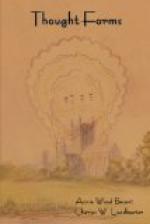Self-Renunciation.—Fig. 16 gives us yet another form of devotion, producing an exquisitely beautiful form of a type quite new to us—a type in which one might at first sight suppose that various graceful shapes belonging to animate nature were being imitated. Fig. 16, for example, is somewhat suggestive of a partially opened flower-bud, while other forms are found to bear a certain resemblance to shells or leaves or tree-shapes. Manifestly, however, these are not and cannot be copies of vegetable or animal forms, and it seems probable that the explanation of the similarity lies very much deeper than that. An analogous and even more significant fact is that some very complex thought-forms can be exactly imitated by the action of certain mechanical forces, as has been said above. While with our present knowledge it would be unwise to attempt a solution of the very fascinating problem presented by these remarkable resemblances, it seems likely that we are obtaining a glimpse across the threshold of a very mighty mystery, for if by certain thoughts we produce a form which has been duplicated by the processes of nature, we have at least a presumption that these forces of nature work along lines somewhat similar to the action of those thoughts. Since the universe is itself a mighty thought-form called into existence by the LOGOS, it may well be that tiny parts of it are also the thought-forms of minor entities engaged in the same work; and thus perhaps we may approach a comprehension of what is meant by the three hundred and thirty million Devas of the Hindus.
[Illustration: FIG. 16. SELF-RENUNCIATION]
This form is of the loveliest pale azure, with a glory of white light shining through it—something indeed to tax the skill even of the indefatigable artist who worked so hard to get them as nearly right as possible. It is what a Catholic would call a definite “act of devotion”—better still, an act of utter selflessness, of self-surrender and renunciation.
INTELLECT
Vague Intellectual Pleasure.—Fig. 18 represents a vague cloud of the same order as those shown in Figs. 8 and 14, but in this case the colour is yellow instead of crimson or blue. Yellow in any of man’s vehicles always indicates intellectual capacity, but its shades vary very much, and it may be complicated by the admixture of other hues. Generally speaking, it has a deeper and duller tint if the intellect is directed chiefly into lower channels, more especially if the objects are selfish. In the astral or mental body of the average man of business it would show itself as yellow ochre, while pure intellect devoted to the study of philosophy or mathematics appears frequently to be golden, and this rises gradually to a beautiful clear and luminous lemon or primrose yellow when a powerful intellect is being employed absolutely unselfishly for the benefit of humanity. Most yellow thought-forms are clearly outlined, and




